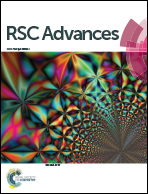Preparation and characterization of PbO2 electrodes from electro-deposition solutions with different copper concentration†
Abstract
The present work focused on studying the effect of Cu2+ concentration on the electrochemical properties of lead dioxide electrodes prepared by electrochemical deposition method. The surface morphology and the structure of the electrodes were characterized by scanning electronic microscopy (SEM) and X-ray diffraction (XRD), respectively. The stability and electrochemical activity of the lead dioxide electrodes were investigated by accelerated life test, linear sweep voltammetry and bulk electrolysis. The results showed that Cu2+ significantly decreased the grain size of lead dioxide and formed a compact and fine surface coating. The service lifetime of the copper modified lead dioxide electrode was longer than that of the unmodified electrode. The electrode prepared from the solution containing 0.2 mol L−1 copper nitrate (marked as PbO2-0.2 M electrode) showed the longest service life (49 h). During the linear sweep test, the PbO2-0.2 M electrode showed the highest electrochemical activity that can be attributed to its highest voltammetric charge quantity. Consequently, the PbO2-0.2 M electrode showed the best performance on degradation of Acid Red G in simulated wastewater by bulk electrolysis. Its pseudo first-order kinetics coefficient was 0.02552 min−1.


 Please wait while we load your content...
Please wait while we load your content...